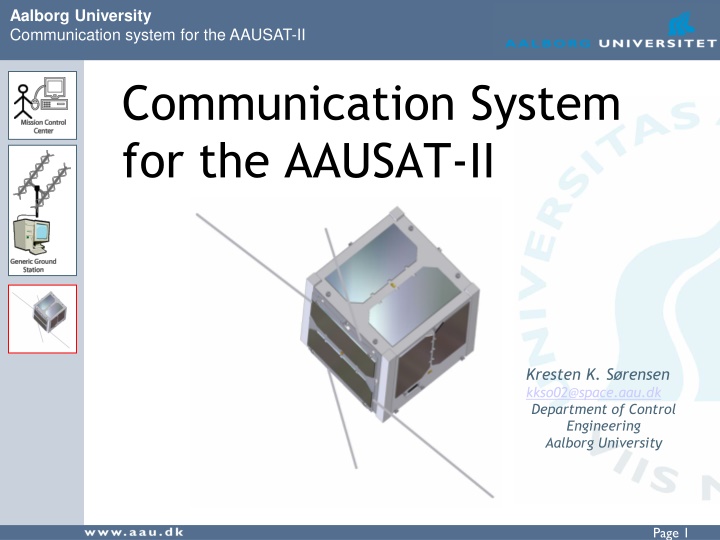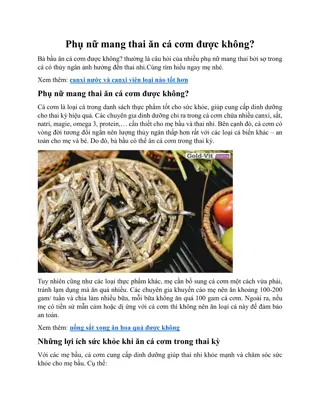
Aalborg University Communication System for AAUSAT-II Overview
Explore the communication system designed by Aalborg University for the AAUSAT-II satellite mission, including mission objectives, system components, specifications, and block diagram. Learn about the purpose, design, and specifications of the communication system, facilitating a communication path between the satellite and Earth while incorporating simple, robust features. Gain insights into the technical aspects and key components such as MCU, Radio, CAN, UART, and Modem. Discover the radio frequency, data rates, modulation, power requirements, and other specifications of the communication system for successful satellite communication.
Download Presentation

Please find below an Image/Link to download the presentation.
The content on the website is provided AS IS for your information and personal use only. It may not be sold, licensed, or shared on other websites without obtaining consent from the author. If you encounter any issues during the download, it is possible that the publisher has removed the file from their server.
You are allowed to download the files provided on this website for personal or commercial use, subject to the condition that they are used lawfully. All files are the property of their respective owners.
The content on the website is provided AS IS for your information and personal use only. It may not be sold, licensed, or shared on other websites without obtaining consent from the author.
E N D
Presentation Transcript
Aalborg University Communication system for the AAUSAT-II Communication System for the AAUSAT-II Kresten K. S rensen kkso02@space.aau.dk Department of Control Engineering Aalborg University Page 1
Aalborg University Communication system for the AAUSAT-II AAUSAT-II Mission Objectives Education Communication (One-way and two-way) Attitude Determination & Control System (Detumbling and pointing) Payload (Gamma Ray Detector) Deploy extra solar panels Upload new software for radio amateur use Page 2
Aalborg University Communication system for the AAUSAT-II AAUSAT-II Overview MECH - Mechanical structure OBC Onboard Computer CDH Command Data Handler COM Communication EPS Electrical Power Supply P/L Payload ADCS Attitude Determination and Control System GND Ground station MCC Mission Control Center Page 3
Aalborg University Communication system for the AAUSAT-II COM System Purpose To create a communication path between the satellite and Earth. Demands Simple, robust design Power saving Small Interface to: CAN, RS232, and Radio Page 4
Aalborg University Communication system for the AAUSAT-II Block Diagram Components MCU Radio CAN UART Modem Page 5
Aalborg University Communication system for the AAUSAT-II Specifications for COM 1/2 Radio Frequency: 437.425 MHz (Half duplex) 6 kHz bandwidth Data rates: 1200/2400/4800 bit/sec FFSK/MSK-modulation Transmitter Power: 0.5 W Link budget: (Worst case) Downlink margin Uplink margin 6,2 dB 20,5 dB CAN bus: 125 kbps Page 6
Aalborg University Communication system for the AAUSAT-II Specifications for COM 2/2 Mass incl. Antenna: Supply voltage: 110g 3.3 V Power Consumption Listening: Receiving: Transmitting: 184.8 mW 283.8 mW 2085.6 mW Page 7
Aalborg University Communication system for the AAUSAT-II Modulation options FSK - Frequency Shift Keying MSK - Minimum Shift Keying GMSK - Gaussian Minimum Shift Keying Page 8
Aalborg University Communication system for the AAUSAT-II MSK Modulation Advantages of MSK modem Good noise performance compared to FSK Easy to use Disadvantages for MSK modem Synchronous interface Synchronization Data must be synchronized to clock The modem synchronize automatically on bit level Synchronization on byte level must be done in software on the MCU Page 9
Aalborg University Communication system for the AAUSAT-II Clock Divider Adds the possibility of bit rates down to 150 bps by dividing the data clock with 1, 2, 4 or 8 Gives more than one symbol per bit and makes the signal easier to demodulate. Page 10
Aalborg University Communication system for the AAUSAT-II Basic Beacon Basic Beacon format: AAUSATII <data> AAUSATII sent as Morse code on FM An 800 Hz Morse tone is sent to the radio Makes it easier to find the satellite Morse tone created with the MCU PWM generator and a low-pass filter Data is modulated by the modem 6 bit battery voltage + 2 bit counter After low- pass filter Page 11
Aalborg University Communication system for the AAUSAT-II Protocol Connectionless AX.25 using UI frames Flags used for synchronization Header for identification of packets Checksum for verification of packet contents Connection orientated AX.25 is to difficult to implement considering our demands The connection orientation is placed on a higher level on the OBC and GND server. Page 12
Aalborg University Communication system for the AAUSAT-II Software Software tasks Relay data between GND and CDH Send basic beacon Collect housekeeping data Interfaces CAN bus USART for modem and radio UART for GND segment and debugging Page 13
Aalborg University Communication system for the AAUSAT-II Software Structure Main module Internal functions Non time critical functions Interrupt module External communication functions Time critical functions Page 14
Aalborg University Communication system for the AAUSAT-II Synchronization Synchronous bit stream without start and stop bits Hardware synchronization difficult The AX.25 flag is used for synchronization Synchronization is done by the ISR CD 101111001001111110011111100111111001 ISR sync. Page 15
Aalborg University Communication system for the AAUSAT-II Pictures Radio prototype Page 16
Aalborg University Communication system for the AAUSAT-II Pictures Modem prototype Page 17
Aalborg University Communication system for the AAUSAT-II Pictures Modem prototype Page 18


